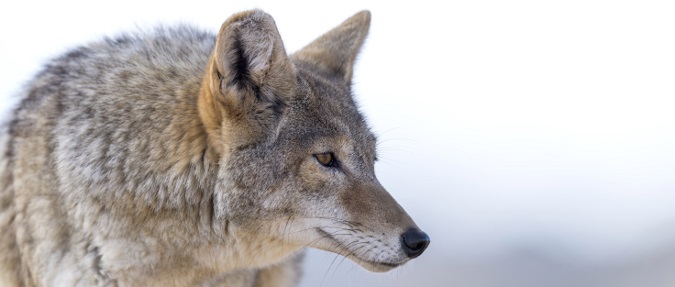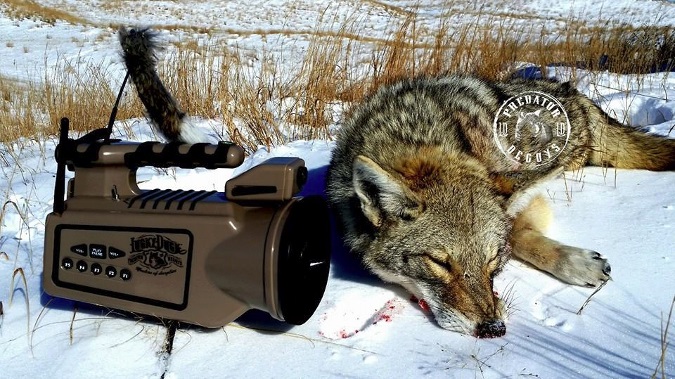Few predator hunters have had such a dramatic impact on coyote populations than Nebraska’s Geoff Nemnich. Not only is Nemnich an extremely accomplished predator hunting, winning the World Championship Coyote Calling Contest in 2014 & 2015, but he is also one of the industry’s best ambassadors. Nemnich holds nothing back, revealing everything he has learned over a lifetime of hunting predators to any hunter who wants to learn. This rare combination of knowledge with a desire and ability to teach sets Nemnich apart. Besides filming the popular Coyote Craze DVD series, Nemnich manages Lucky Duck’s predator pro staff and worked extensively with Lucky Duck this past season to develop the new Revolution E-Caller.

We had the opportunity to pick Geoff Nemnich’s brain for this article highlighting some of the hottest trends and considerations for hunting today’s pressured coyotes. As usual, his insight is spot on and invaluable for both beginning predator hunters and seasoned vets.
Q: How have coyotes changed over the past ten years in response to calls
A: Honestly I don’t feel that the coyote species as a whole has changed their behavior over the past 10 years in response to calls or because of the advancement of the electronic call market or an increase in hunting pressure. A coyote is still a coyote and each year more than 50% of the coyote population is made up of pup coyotes that haven’t experienced being pressured yet. What you get though with this increase in the predator hunting segment are coyotes that are pressured earlier in the season and at a more frequent rate. This leads to individual coyotes changing their behavior earlier in the season now as compared to 10 years ago.
Q: How does the terrain and weather affect how you set up your stand
A: Terrain and weather play a big part in the decision making process when setting up a stand. When looking at terrain I’m specifically looking for areas where I can get my vehicle hidden from the calling area as well as make a stealthy approach into my stand. Early morning or late in the day I’m going to key in on transition areas where coyotes will more than likely be on the move hunting. These stands are generally more open with greater visibility. Now during the middle part of the day I’m going to key in on bedding areas or the thickest, roughest areas I can find. These stands are generally tighter with minimal visibility. In regards to the weather, I’m specifically concerned with the wind speed and direction. The greater the wind speed, the thicker the cover I’ll find to call in. As far as wind direction, I’m always going to approach a stand with the wind in my face or any variation out to a 90 degree crosswind. This will ensure that the coyotes that I’m hoping are in the area to be called in, have minimal chance to come in contact with my scent as they approach the sound of the call.
Q: What are your overall calling strategies for early season
A: When developing a strategy for calling coyotes it’s important to understand coyote biology and the dynamic of coyotes being pressured throughout the season. Early on in the season, I’m guessing anywhere from 40%-70% of the coyote population in an area is composed of 6 month old pups. By October most of these pups will start dispersing across the landscape and colder temps deplete easy food sources like insects and fruits. These coyotes will now have to actively hunt small mammals like rabbits and rodents. Even the adult coyotes have grown less cautious with the minimal hunting pressure over the previous 6 months. Keeping all this in mind, I’ll focus my sound sequences on prey distress and pup distress sounds. Getting to aggressive with coyote vocals and fights can easily intimidate these pup coyotes that are dispersing across the area and keep them from approaching the call.
Q: How do your calling strategies change going into late season?
A: As we move into late season, the strategies once again change based off of coyote biology and the dynamic of coyotes being pressured for the previous 4 months. This is the time of year when even the most seasoned coyote hunters will struggle. In many cases the coyote population will be 50% less than what it was 4 months earlier and the remaining coyotes have more than likely been pressured or stressed in some way. Luckily for us, coyotes switch gears and start thinking about the continued existence of their species with the onset of breeding season. This opens a small window of opportunity for hunters if they are able to capitalize on it. In most cases I’ll shy completely away from prey distress sounds and use nothing but coyote vocalizations, fights, and breeding sounds. This is where having an ecall with an extensive amount of these types of coyote sounds will pay big dividends!

Q: What are the advantages of the E-Caller and how do you use this?
A: There are really 2 huge advantages to using an ecall. The first is being able to get the ecall out away from your position with the use of a remote. Coyotes are a top-notch predator and their eye sight is exceptional. Keeping their focus on the ecall and away from your position will buy you some extra time when it comes to getting a quality shot off. The second advantage is the diversity of sounds you can find on an ecall. Let’s take the Revolution ecall by Lucky Duck for example. This call is filled with 100 real animal sounds that have been recorded in such a manner that the sound quality is second to none. Of these 100 sounds, more than 50 fall into the very important category of coyote sounds. These coyote vocals, fights, distresses, whimpers, and even estrous chirps are exactly what coyote hunters will need in order to be successful later in the season and the more choices you have the better your odds will be!
Q: Explain typical scenarios where you switch up sounds and volumes as coyotes approach.
A: Reading a coyote’s body language as they approach really dictates how I’ll regulate the sound and volume. If the coyotes is on a fast trot or run I’ll typically leave the call running on the same sound and at the same volume until they are close enough to stop and kill. If for some reason the coyote hangs up, sits down, or loses interest during their approach, I’ll typically start switching sounds and possible the volume level to see if I can re-gain their interest. Sometimes I may elect to go with a more aggressive sound like a coyote fight or coyote distress. Other times I may go with a more subtle sound like rodent squeaks. But regardless, don’t be afraid to switch up the sounds multiple times in order to get the results you want!
Q: What trends and changes in predator hunting do you anticipate over the next ten years
A: In terms of coyote hunting popularity I think we’ll continue to see an upward swing in numbers. More and more hunters are realizing the upsides to predator hunting like extended seasons, unlimited bag limits and the benefits to other game by managing predators. On the downside, more and more hunters are realizing just how difficult it can be to go out and successfully call in and kill coyotes. I think there will always be a steady influx of new hunters and hunters that give predator hunting a try a few times and then move onto something different. But above all, there will always be a tremendous amount of coyotes to hunt! In terms of technology, I see a greater increase in night hunting with the use of thermal and night vision equipment over the next 10 years by predator hunters wanting to gain as much as an advantage as they can. Also with the advancement of technology, I think we’ll start to see cheaper, more compact ecalls that will still offer all of the same big advantages that the more expensive ecalls offer today. Features like a built-in camera and revolving base in which the Revolution ecall offers, are just the tip of the iceberg when it comes to new and exciting additions to ecalls we’ll see in the future!
By Jim Cunningham
